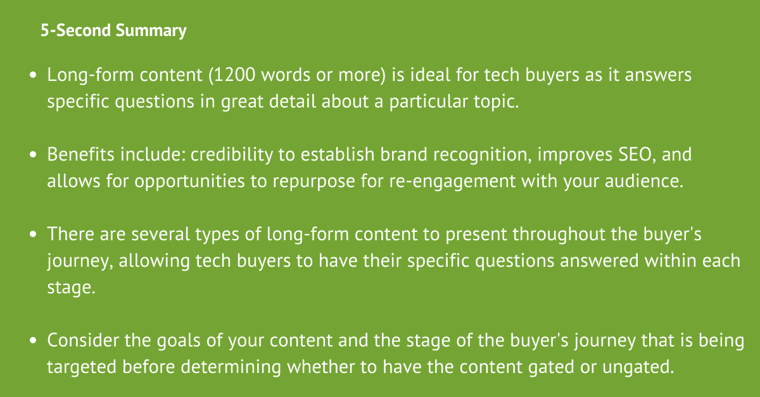
Since the rise of content marketing following the onset of the digital era, technology buyers have come to expect high-quality, valuable content. With 87% of tech buyers wanting to “self-serve part or all of their buying journey,” not only does content have to be meaningful, it also needs to be responsive to the buyers’ place in their decision process (TrustRadius).

As a result, it becomes critical for marketers to create content that addresses the essential questions of tech buyers at each stage in their buying journey, using the most effective content type. As most technology purchases involve complex, sophisticated products, the length and breadth of long-form content makes it an ideal content choice for technology marketers.
What is long-form content?
Although the definition of long-form content can vary depending on who you ask, it typically describes a piece of writing that is more than 1,200 words. Long-form content is designed to cover topics in great depth and educate motivated readers who are looking for answers to specific questions or more detailed information about a particular topic. Some examples of long-form content include white papers, ebooks, articles, case studies, and webinars. The Content Marketing Institute believes that long-form content can be appropriate for every stage in the buyer’s journey and considers it an essential part of any content strategy.
Short-form content on the other hand, is typically less than 1,000 words and gives the reader a quick answer to a question, a general product overview, or an explanation of a small portion of a product. Some examples of short-form content include blog posts, email newsletters, social content, and infographics.
Why do you need long-form content?
In addition to delivering value to its target audience, long-form content also provides marketers with many benefits:
-
Positions you as an authority in your industry:
Creating a catalog of valuable long-form content can help you build credibility and make your website the place to go to get key questions answered. Credibility helps to establish brand recognition, which is especially important to technology buyers who are overwhelmed with marketing messaging from multiple vendors daily.
-
Improves your site’s search engine results:
Since long-form content is copy heavy, it is very easy for search engines to analyze and index, thereby improving ranking results. In addition, long-form content typically contains more keyword phrases (long-tail keywords) that readers use when searching for specific information online. These keyword phrase matchups let search engines know that you have high-quality, relevant content for that topic, increasing your search engine results. Readers will also spend more time on a page with long-form content, indicating to search engines that the page’s information is helpful and valuable. As a result, search engines are more likely to suggest the page with your long-form content over others.
-
Allows opportunities for reuse and repurpose:
When written with longevity in mind, long-form content can become a fundamental component of your website. Long-form content that discusses topics that stay relevant regardless of passing time, also called evergreen content, works to further increase your credibility and organic traffic. Long-form content can also be repurposed into smaller, bite-sized pieces of content such as infographics, short videos, or social content. Repurposing long-form content gives your audience multiple opportunities to engage with your valuable insights and helps to reinforce your message.
Long-form content for the tech buyer’s journey:
Technology buyers have specific questions and concerns at each stage in their decision process. Presenting relevant long-form content at each stage will help you successfully move these prospects through their journey. We’ve put together a list of long-form content examples for each stage in the tech buyer’s journey, based on common buyer questions and concerns:
.png?width=760&height=817&name=Marketing%20Table%20List%20Infographic%20Graph%20(1).png)
Should your long-form content be gated or ungated?
After creating a well-written, valuable piece of long-form content, marketers often struggle with the decision on whether it should be gated or ungated. When grappling with this decision, consider the goals of your content and the stage of the buyer’s journey for which it is targeted. Gated content is content that viewers can only access after exchanging their information and is therefore a strategy used for lead generation. Content that is ungated is used by marketers to improve SEO and increase brand awareness and trust with their target audience.
In addition to considering your content goals, you should also keep your target audience in mind. According to Spiceworks, “IT pros aren’t big fans of gated content," with research showing that ungated content gets more downloads and shares. Tech professionals want access to great information quickly and don’t want to worry about being inundated by emails and phone calls from you as soon as they submit their information. If you do decide to make your long-form content gated, make sure the value you are providing is substantial and design an easy to complete form by limiting fields to only name and email address. Successful content marketing strategies should include a mix of both gated and ungated long-form content.
Interested in learning more about long-form content?

.png?width=252&height=82&name=gameplanmktg_logo_white%20(1).png)
